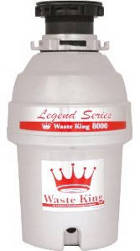 Make sure the drain plug on the garbage disposal is removed. That’s the short answer. The longer story follows.
Make sure the drain plug on the garbage disposal is removed. That’s the short answer. The longer story follows.
I’m an idiot and didn’t think there would be a plug there. Guess what happened the first time the dishwasher ran after the new garbage disposal was in place? The dishwasher was full of water after it ran. I scratched my head, puzzled. I knew it had something to do with my [1] handy work. After doing a quick web search I was reminded that the garbage disposal has a plug where the dishwasher drain hose connects. I thought there would be a simple plug there you could pull out or unscrew. I was wrong. Turns out on the model I purchased (a Waste King 8000 Legend, sounds impressive, no?) I have to punch the plug, which means it goes inside the disposal and is impossible to reach without dismounting the garbage disposal from the sink. Ugh. I have to clear out underneath the sink again, unplug from the outlet, unhook the drain pipe, and dismount the garbage disposal? Maybe not. Straight from the owner’s guide:
When knockout plug falls into disposer, you may remove it or simply grind it up when the disposer is used.
Jackpot. Or not. As later in the same guide it provides these pearls of wisdom:
Your disposer is ruggedly built to give you many years of trouble free service. It will handle all normal food wastes, but it will NOT grind or dispose of such items as plastic, tin cans, bottle caps, glass, china, leather, cloth, rubber, string, clam and oyster shells, aluminum foil or feathers.
I rationalized there is only one way to see if this beast lives up to its brand name. I knocked the plug into the garbage disposal and ground it up. I then turned the dishwasher back on and the water disappeared within a minute. Problem solved.
[1] I can’t take all the credit. Many thanks to a man known as The Jackal for helping me make magic happen – almost.